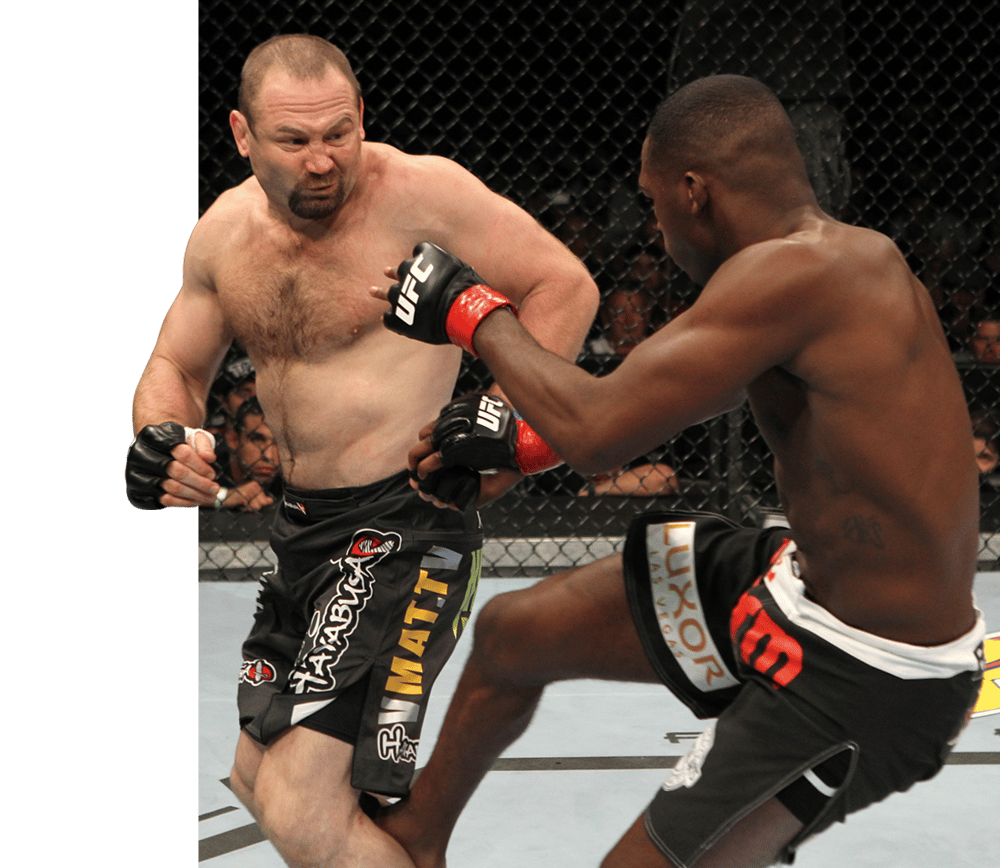
Issue 068
October 2010
UFC referee Marc Goddard brings fight fans the ref’s side of the story.
I was absolutely enthralled by Anderson Silva and Chael Sonnen’s recent middleweight championship clash. Sonnen sustained a hellacious pace until Silva snatched a dramatic victory by triangle/armbar halfway through the fifth and final round. But plenty of viewers attending and watching around the world were left confused by referee Josh Rosenthal’s halt to the bout and the ‘submission’ by Sonnen, demonstrated by a single tap against Silva’s leg.
It’s a common misconception that a submission’s signaled by the defeated fighter tapping three times to the canvas, his opponent’s body, or with a verbal declaration. That’s by no means true. The fight’s over when any of the combatants makes ‘a single gesture’, physical or otherwise, that he wishes to be released from a fight-ending hold. Just like Fedor Emelianenko earlier this year.
If the rules cited ‘three taps’ as some observers mistakenly think they do, that’d only lead to further confusion. Imagine the controversy caused by a stoppage after ‘two taps’ in a title bout as significant and scrutinized as Silva vs Sonnen. Equally, consider the potential fracas if the ‘three taps’ rule was applied to verbal submissions. A fighter deep in an armbar cries out once, I ignore his appeal and a serious injury occurs – because I only heard one plea and not three? It’s hypothetical but I’m sure you see the point. Any single gesture by a fighter that he wishes to end the contest and it’s over, no question.

CRUCIFIX POSITIONS
When should the ref stop a fight that appears to have culminated in the ‘crucifix’ position?
The dominant ‘crucifix’ position’s becoming more and more popular. (It’s also sometimes known as the ‘Salaverry’ after Ivan Salaverry, the retired fighter who popularized the position). The ‘crucified’ fighter is pinned on his back as his opponent lies high across his upper body. One of the bottom man’s arms is pinned outstretched by the hooked legs of the top player, and the other is held by a combination of the top man’s weight, his own arm, and his head planted on the canvas. The bottom man has the appearance of being nailed to a ‘crucifix’. Admittedly it’s a lurid term.
This is a difficult a position to escape from. It’s also dangerous as the trapped player’s arms aren’t free to block any strikes from the attacking opponent – who capitalizes heavily hammering down blows, usually elbows, to an undefended head. Should this mean an automatic end to the contest? Mostly, yes. A notable example is the recent UFC Jon Jones vs Vladimir Matyushenko contest on Versus. Jones established a crucifix early in the first round. Once Matyushenko was pinned Jones unleashed a volley of elbows so fast and ferocious that it left referee Herb Dean no option but to call a halt to the contest. In different instances the attacking player doesn’t always release a torrent of non-stop strikes, as he may still be trying to settle for base. Or perhaps his opponent underneath is escaping, and unsettling the top man.
The crucifix ties in with the Unified Rules of MMA as a referee will stop the contest if a fighter can’t intelligently defend himself. This is usually in the case of TKO or a concussive blow where a fighter may not be in full receipt of his faculties. What’s so unique about the crucifix is usually the trapped fighter does know how to defend himself and is fully aware. But due to the nature of the position he’s simply unable to protect himself, leaving the referee no choice but to fulfill his role.
ASK THE REF: Q&A
Don’t know your DQs from your decisions? Marc answers your questions on the ‘Unified Rules’ used in MMA
Q: After Dan Mirgliotta warned Anderson Silva about his antics at UFC 112, I wonder could a referee disqualify a fighter for doing something like this (running away, not attacking, etc)?
Martin, Dublin
A: The Ref says: Hi Martin, I actually covered this very incident before and the application of deduction of points. For sure a ref can disqualify a fighter for persistent fouling but this is a very rare occurrence. I can imagine a situation where a fighter was DQ’d after persistent point deductions and other warnings were ignored.
Q: Strikeforce don’t allow elbows in their fights. How is it that promotions have different rules? Could a promotion take away, or add, any rules it feels?
Brad, NY
A: The Ref says: Hi Brad, yes, certain rule omissions can be applied. In the US the state athletic commissions would oversee the deletion of the appropriate rule – certain American states have their own do’s and don’t’s. The most notable was when Pride first went to the US in 2006 and the athletes had to compete under regulation three-times-five-minute rounds instead of the regular Pride opening round of ten minutes, followed by a further two five-minute rounds. The UK with its absence of a commission can be more liberal.










